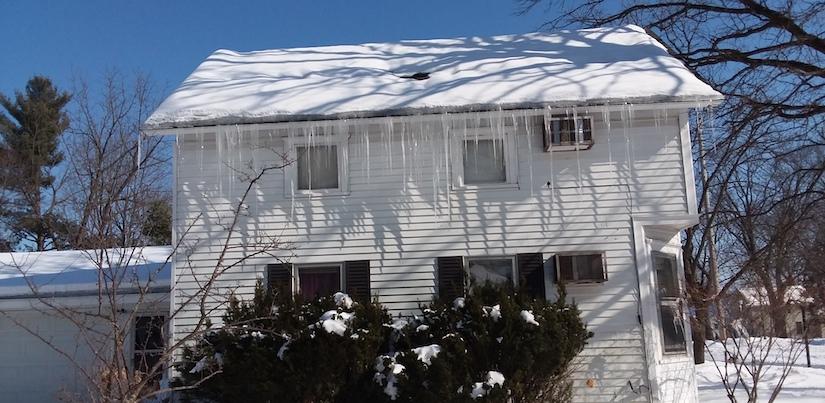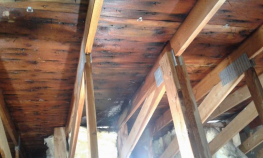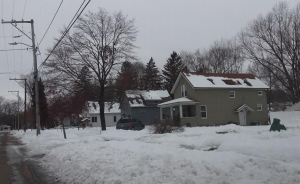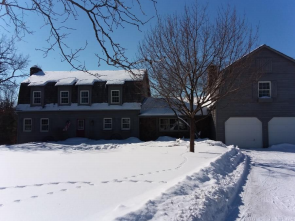- Residential
- Commercial & Municipal
- Building Consulting

The roof of a home during Winter tells a story about the performance and energy efficiency of the entire structure. The location of attic features which need to be air sealed can largely be identified from the exterior by an experienced observer when there are ice dams, based on the age and type of home. If the roof shows an irregular pattern of snow melt or if there are large icicles and ice dams it is also likely the building is drafty and uncomfortable, with high energy bills. Such a building would benefit from having attic air leaks sealed and then having blown-in insulation added to R50 or even R60.
Although story-and-a-half homes are particularly susceptible to ice dams due to hidden air leakage pathways and a variety of features that complicate making a tight building envelope, a building of any age or style that has excessive attic air leaks or lacks attic insulation can have ice dams. A trend in new construction of the last several decades has been to add a lot of architectural features (variations in ceiling heights, vaulted ceilings, tray ceilings, cantilevers, recessed lights, bonus rooms, dormers, gas fireplaces, etc.) to make the building visually appealing. All of these building features complicate making a tight building envelope, and do nothing to prevent ice dams from forming. Newer homes can be as drafty and have ice dam issues like much older buildings.

Sometimes building “improvements” compromise the energy saving performance of the home. A prime example is when recessed lights are added to a room and the installing electrician does not restore the insulation to original condition or tramples what insulation there is. Uneven insulation levels or in some case bare spots are created, which contributes to the formation of ice dams. Additionally, recessed lights almost always leak some air, and their installation involves cutting holes in the thermal envelope of the building.

Another problem is when an attic is re-insulated without sealing attic air leaks. The result can be attic condensation issues. Warm air is still entering the attic through the unsealed air leaks. The underside of the roof deck attic is now cooler due to the added insulation and becomes a location for frost to form. When there is a Spring thaw the frost melts. In some cases, there is enough dripping water to cause damage to ceiling or wall surfaces.
Installing electric heat cables or shoveling snow off a roof are ways to deal with ice dams without really fixing the root causes. Sometimes a roofing contractor is called in to offer an opinion and possibly install ice and water shield or add roof ventilation. These measures will generally help, but once again do not eliminate the cause of ice dams.

The correct approach is a comprehensive solution, using the “Building as a System” concept. The “Building as a System” approach takes into account the interaction of building components and occupant behavior, especially when a change is made in the building or how the building is used by occupants. For example, the installation of a new powerful kitchen exhaust fan will likely cause an atmospherically vented gas water heater to backdraft, creating a combustion safety issue.
These are the steps that can be taken to eliminate ice dams, improve home comfort, occupant safety, and reduce energy costs:
- Attic air sealing. Use one-part or two-part spray foam or caulk and air barrier materials (rigid foam board for example) to seal attic air leaks.
Examples of locations to seal: Wiring and plumbing penetrations, drop soffits, top plate seams, knee-wall transitions, chimney chases, recessed lights, etc. - Install attic ventilation chutes, add attic venting if needed. • Add loose blown cellulose insulation to R50, use dense pack cellulose in enclosed cavities to capacity; weather-strip and insulate attic hatches or doors.
- Every Kitchen or Bathroom should have an exhaust fan that vents to the exterior. For best exhaust fan flow use 4” rigid metal duct with minimal bends or elbows. Venting through the roof works best.
- Combustion safety testing on gas appliances like furnaces, water heaters and stoves increases in importance as the home is tightened up.
February and March of 2019 had below zero temperatures and a series of snowstorms throughout much of Wisconsin, ideal conditions for the formation of ice dams and high energy bills. 2020 (so far) has had relatively mild weather. Regardless of how mild or severe Winter weather is, the best practice is to have a tightly built and well insulated building envelope. The absence of ice dams and icicles on your roof in Winter tells your neighbors that your home is well built and a comfortable place to be.

